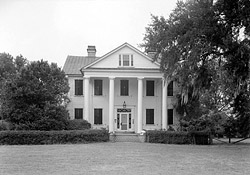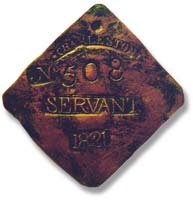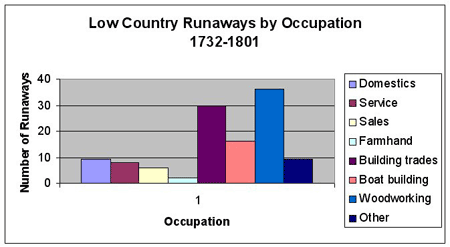Internal Economy and Human Identity
Participation in the evolving internal slave economy offered Africans many advantages. People learned potential escape routes as they traveled between the plantation and Charles Town or Savannah markets. Earning money offered opportunities for people to buy goods and services for their family members. Marketing their produce offered enslaved Africans opportunities to maintain family ties as they visited other plantations and to develop a sense of community with kith and kin, former shipmates and newly found friends in urban market places. There in the relative anonymity of the urban scene people had occasion to socialize, hear the latest news and to plan resistance, rebellion and escapes to Spanish Florida. Growing their own food allowed people to control their own diet. Africans used “their” land to grow African varieties of food, corn, groundnuts, sesame, and pepper, enabling them to continue familiar foodways and to introduce new foods into the diet of the Europeans. Probably the most significant aspect of the internal economy, was its contribution to the idea of Africans as human beings, people with rights and responsibilities, was perhaps the least obvious and most tenuous.
The internal slave economy helped to establish a human identity for enslaved people. The English regarded “Negroes” as chattel, property, much like their other live stock property. These beliefs are expressed in colonial laws, travelogues, account books, probate inventories, wills and in demeaning descriptions and images of enslaved Africans.
After laws made slave status inherited and permanent, only rarely did enslaved Africans or American-born Africans gain their freedom for some achievement. Yet, enslaved people believed themselves to be humans with all the rights of other people and they expressed this in their behaviors, their naming patterns, their formation of families and communities, and in their striving for self-determination.
African people coming directly from the continent had a different conceptualization of what it meant to be enslaved. The slave system they knew was more flexible and allowed for the social integration of enslaved people into the lineages that structured and organized their societies. Enslaved people in Africa could regain their freedom through individual achievement. West African slavery was thus not necessarily permanent and recognized the personal status and individuality of those enslaved.
African Americans with no other experience than enslavement still believed themselves humans with the right to be treated with human dignity.
“It is a mistake to suppose that the southern planters could ever retain their property, or live amongst their slaves, if those slaves were not kept in terror of the punishment that would follow acts of violence disorder.” … said Charles Ball … “There is no difference between the feelings of different races of men, as far as their personal rights are concerned. The black man is anxious to possess and to enjoy liberty as the white one would be if he were deprived of this inestimable blessing…(Ball 1837:379).”
Nowhere in colonial life was the opposition between these two belief systems expressed more frequently than in the many ways that Africans contested the use of their time in the service of slave owners. Even in the most oppressive slave—slave-owner encounters, Africans’ challenged the right of the slave owner to the use of their time. If not outright, then subtly, using what one anthropologist has called “Weapon’s of the Weak,” enslaved Africans manipulated the plantation economic dependence on their labor through malingered illness, feigned ignorance of language and customs, and deliberate mis-understanding of directions. (Scott 1995:305–306; Campbell 2000). Presaging labor tactics of the 19th and 20th century, the Africans were no strangers to use of “slow downs” and “walkouts” as the multitude of runaway advertisements eloquently attest.
Thus, the notion of “free time,” so necessary to the creation and maintenance of the internal economy, was also a highly contested commodity that spoke to people’s identity as humans. To own one’s time implies a right to person-hood and individuality unfettered by the demands of another, in this case the slave owner. The acts of negotiation between slave and slave owner over “free” time,” and the products produced in that time, implicitly recognized the enslaved individual as a person with certain rights (Campbell 2000).
The African American internal economy gave lie to caricatures of enslaved people as lazy and unable to work independently. The internal economy established a recognized terrain of mutual interdependence between enslaved African people and the planters. Recognition of their dependence on Africans for subsistence foods, goods and services were constant, if subtle, reminders to the slave owners of the African’s humanity.
Finally, the identity of the African as “human” came full circle when African people used their income to acquire the material evidence of their person-hood in terms the English understood and valued. As Africans acquired material possessions, livestock and land, as they exchanged, inherited property, and, when possible, bought themselves out of slavery, they defined themselves as human.
In a wider context, the Low Country plantation system, including the tasking of labor, planters’ dependence on continued importation of Africans, the black majority in the regional population and the economic success of rice and sea island cotton-based economies gave rise to social class differences among African Americans. Social differences informed variation in the cultures of urban versus plantation-based African populations. Social class distinctions developed among enslaved people based on work roles: that is, artisans, domestics, or field workers; free versus enslaved, American-born versus African-born, and skin color from black to near-white. The next section discusses the emerging social differences and parallel cultural constructions of African peoples as they molded an African American culture.
Culture Change: Evolution of African American Artisans
As the 18th century came to a close and the new nation expanded its boundaries along with its influence in the world, the majority of all Africans and African Americans in the southern colonies lived in rural settings. There they were mostly agricultural workers and unskilled laborers such as draymen and stevedores. Throughout the course of the 18th century, many slave holders resisted the idea of teaching enslaved people various trades. But in the end necessity overcame their reluctance and a class of artisans of African descent emerged, more so in the North than the South, more in towns and cities than in rural areas, and more in the Low Country than in the Chesapeake region.
Although since antiquity, Africans had engaged in iron, wood and gold working, designing and building places to work, weaving, tanning and tool-making, in the Americas their labor was used to clear land, plant and grow subsistence and cash crops. The planter class argued that craftsmanship which produced little surplus for profit was a less productive use of enslaved people’s labor. In 1731, as one South Carolina resident commented about European artisans:
“Artificers are so scarce at present that all sorts of work is very dear; Taylors [sic], Shoemakers, Smiths &c. would be particularly acceptable…. A skilful [sic] carpenter is not ashamed to demand 30s per Day besides his Diet… (J.P. Purry, et al. as quoted in Stavisky 1947:Ftn. 4, Pp. 319).”
Citing South Carolina colonials complaint to the Governor and King, Morgan reports that as early as 1734, the ruling authorities of South Carolina expressed concern at how “ many negroes are now train’d [sic] be Handicraft tradesmen, to the great discouragement of Your Majesty’s White Subjects (Morgan 1998:226).”
In spite of these attitudes toward “Negro” labor during the colonial period, African American artisans carved out a niche for themselves in the Southern economy. By 1750, Bolzius would report:
“There are in Carolina all kinds of craftsmen necessary for the country, such as carpenters, masons, blacksmiths, locksmiths, shoemakers, tailors, saddle makers, coopers, carriage builders, tanners, gunsmiths, turners, weavers But since the Negroes learn all kinds of common and useful crafts, the poor [white] craftsmen cannot succeed. In Georgia, Negroes are not allowed to learn a craft except the cooper craft. There is still a shortage of carpenters, turners, brickmakers,[sic] carriage builders and potters in Georgia (Bolzius 1750:242, Translated and edited by Loewald, Starika and Taylor, 1957).”
The high cost of European artisan’s labor was compounded by the rapid turnover of artisans as free white people succumbed to the lure of vast territories of low cost land. In a short period of time a white craftsman could amass sufficient funds to become an independent landowner, compounding the shortage of skilled laborers. The solution was a new source of industrial labor that was low cost and thought to be less likely, in comparison to Whites, to be able to blend in with the population should they desire to leave their employer.
Some Europeans feared that enslaved craftsmen would use tools to make weapons as in fact one blacksmith did, making three hundred spears intended for an insurrection in Virginia. Other Europeans were disturbed by the notion of enslaved people gaining other kinds of knowledge, like the means and avenues to escape slavery, greater confidence associating with Whites, and generally becoming likely to be less subservient. These misgivings were especially associated with the idea of training artisans from the large population of enslaved people in cities (Stavisky 1947:420–423). In spite of these misgivings, increasingly over the 18th century, necessity forced Whites to use the skills of Africans and to train them in new skills so that enslaved people came to monopolize crafts in South Carolina.
Thirty-odd years after Bolzius reported only a few “negro” artisans, Dr. Schoepf a European traveler touring the new Confederation of States in North America noted:
“‘The gentlemen in this country have among their negroes as the Russian nobility among the serfs, the most necessary handicrafts-men, cobblers, tailors, carpenters, smiths, and the like, whose work they command the smallest price or for nothing almost. There is hardly any trade or craft, which has not been learned and is not carried out by Negroes, partly free, partly slave; the latter are hired out by their owners for days wages…. (Johann D. Schoepf, “Travels in the Confederation,” 1784:220).
Woodwork and Building Trades
Starting with woodworking, enslaved men in the Low Country moved into the trades of sawyer, carpenter, coachmaker, boat builder, coffin- maker, cabinet maker, house-carpenter, wheelwright and boat mender. Others became bricklayers, brick makers and blacksmiths.
The plantation system relied heavily on slave craftsmen imported from Africa. Written records and examination of many of these buildings indicate slave participation in their construction, such as Magnolia in Plaquemine’s Parish, Louisiana in 1785, the Gippy Plantation, in South Carolina, Windsor Hall in Greenville, Georgia and others (African American Registry 2004). Some slave artisans were hired out to other owners such as, James Bell of Virginia, who was sent to Alabama to construct three spiral staircases for the Watkins-Moore-Grayson mansion. A number of free African Americans also designed and built houses in the antebellum South. For example, Charles, a free African American carpenter, wood worker, and mason, contracted with Robin de Logny in 1787 to build Destrehan Plantation in St. Charles Parish, Louisiana.
Enslaved African American iron workers made the decorative hand-wrought grills and balconies found in the older quarters of Charleston attesting to the quality of 18th century slave labor (Stavisky 1949:323). It is generally agreed that most of the exquisite ornamental iron work of New Orleans was the work of “negro” slave blacksmith. Most of the extant New Orleans iron work is post-Revolutionary, due to the fire which almost entirely destroyed the city in 1780. The wrought-iron of Charleston, South Carolina offers many more examples of pre-Revolutionary work and most of it was the work of enslaved African American craftsmen. The ironwork at Drayton Hall Plantation is thought to be the work of enslaved ironworkers.
“[C]raftsmen of immense ability also created the carved plaster ceilings at Drayton Hall. These unnamed craftsmen were both the recipients and the conveyors of the building and design traditions of Western culture, but one of the enduring ironies of Drayton Hall is that this deliberate expression of the rational was actually built by African slaves. Every brick testifies at once to the skill of African Americans and to the folly of their captivity (Gillette, [1991] 2004).
Charleston supported the most specialized craftsmen in shipyards, the manufacture of candles and soap, as tailors, butchers, bakers, and barbers. Some were even employed in silver-smithing, gun-smithing, harness-making, and chair-making (Morgan 1998:229). Enslaved men were goldbeaters and cabinet makers (Berlin 1980:63).
Even though slave-owners tended to prefer training “American-born” enslaved people in artisan skills, not all enslaved artisans plied trades learned in the Americas. As noted earlier, building construction, construction with tabby brick, blacksmithing, basket making and pottery making were skills that some enslaved people brought with them from Africa. Barring the temporary ten year hiatus in the importation of African into Low-Country after the Stono Rebellion, Low Country planters continued to import “salt-water Negroes,” that is African-born people into South Carolina until the end of the transatlantic slave trade.
Market Women
Women also developed skills. Many were spinners, seamstresses; others made soap and starch and dyed clothing (Franklin 1943:143). Women were the hucksters in Low Country, as they had been in Africa, Caribbean and South America, so they were in Charlestown. According to Morgan, slave women hawked cakes, tarts, and bread about the city streets; others peddled milk, garden produce, and fruit; one even sold sand. The large urban market in Charlestown also offered enslaved men opportunities to sell meat and fish for the slave-owners and for themselves. A petition presented to the Charlestown assembly in 1747 describes the situation.:
“[Their masters] give them all imaginable liberty, not only to buy and sell those commodities, but also, … to forestall the markets of Charles Town by buying up the Provisions, &c. which come to town for sale, at dear and exorbitant prices, and take what other indirect methods they please, provided they pay their masters their wages, which they seldom or never enquire how they came by the same, … [further] those Negroes and other slaves, being possessed of large sums of money, purchase quantities of flour, butter, apples, &ca., all which they retail out to the inhabitants of Charles Town, by which means leading lazy lives, and free from the government of their masters. [Emphasis added] Stavisky 1949).”
“Hire” Badges
The 1747 petition refers to the practice of hiring out enslaved people. Beginning in the 1720s, several Southern cities permitted slave owners to hire out their skilled servants. Slaves who were hired-out were required to wear “hire badges.” An unaccompanied enslaved craftsman found without a badge could be arrested and his master forced to pay a fine for his return. The only badges known to survive are from Charlestown and most are from the 19th century (South Carolina State Museum 2004).
Many enslaved African Americans living in cities hired their own time, earned wages for “overwork,” kept market stalls, and sometimes even opened shops. Some lived apart from the slave owner and rented houses of their own, paying the owner a portion of their earnings in return for de facto freedom. This allowed enslaved people to keep their families in tact, accumulate person property and develop small communities in Savannah and Charles Town (Berlin 1980:63–64).
Berlin comments, that the Low Country plantation system with its urban centers, its black majority, its dependence on “salt-water” Africans transformed African American culture and society while simultaneously reshaping the white world (Berlin 1980:63). During the 18th century, Africans and African Americans composed more than half the population of Charles Town, Savannah and other low country ports. Few commodities arrived or left these cities without some black hands handling it. Master craftsmen employed African and African American artisans in every variety of work. Service entrepreneurs like barbers also employed enslaved people in their establishments.
By the end of the 18th century all of the misgivings that slaveholders expressed in regard to creating an educated, trained non-agricultural-based workforce materialized. A few enslaved people resisted enslavement by outright rebellion, more paid their way out of slavery, and many more took their freedom, running away. This was as true in the Low Country as it was in the Chesapeake.
African American men increasingly manned the boats plying South Carolina rivers. Alleged slave conspiracy uncovered evidence that most of the boats used in the conspiracy were manned by enslaved men, including the boats helmsmen (Morgan 1998:239).
The impact of the internal slave economy, emergence of social class differentiation, and acculturation on African and African American people’s world view was evident in their sacred and secular rites, ceremonies, rituals, art, music, dance, personal adornment, celebrations and many other socio-cultural customs and practices. The Revolutionary War and the events surrounding the War, propelled African Americans toward the new century and toward their destiny in American history as catalysts of far-reaching change in the social, economic and cultural fabric of the new nation. The next two sections examine these facets of African American heritage as they materialized in the Southern Colonies.











